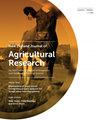A framework for applying interceptive mitigations for diffuse agricultural pollution
IF 1.5
3区 农林科学
Q2 AGRICULTURE, MULTIDISCIPLINARY
New Zealand Journal of Agricultural Research
Pub Date : 2023-09-13
DOI:10.1080/00288233.2023.2252773
引用次数: 0
Abstract
ABSTRACTInterceptive mitigation options implemented at the edge of agricultural fields and along run-off and drainage flow-paths can complement preventive in-field management actions to reduce diffuse contaminant losses to surface waters. However, it is often unclear to users which interceptive mitigation option is appropriate for their situation, where it should be located, what contaminant reductions and other benefits can be achieved, and what it would cost to implement, maintain, and operate these practices. We outline a framework for selecting and applying eight interceptive diffuse pollution mitigation practices potentially applicable on New Zealand farms: riparian grass filter, planted and multifunction buffers; constructed wetlands; woodchip bioreactors; filamentous algal nutrient scrubbers; sediment traps; and detainment bunds. The framework provides users with a semi-quantitative evaluation of the relative benefits and costs of the best suited mitigations across a range of farmed landscapes. It highlights where each mitigation has its niche in terms of the landscape fit, flow-path(s) intercepted, contaminant(s) targeted, efficacy, associated co-benefits, relative cost, operation and maintenance requirements, longevity, and consenting requirements. Testing and refinement of this framework is encouraged, using data from field-scale implementation, to better quantify efficacy in practice, and inform empirical models and decision making across farm and catchment scales.KEYWORDS: Diffuse pollutionagricultural run-offdecision support toolnature based solutionsriparian buffersconstructed wetlandsdenitrifying bioreactoralgal nutrient scrubber AcknowledgementsWe thank our colleagues, in particular Lucy McKergow, Fleur Matheson, James Sukias, Rupert Craggs, Erina Watene-Rawhiri, and members of our Iwi Advisory Panel, in particular John Te Maru, for useful discussions and contributions to the development of the framework presented here. We are also grateful to the reviewers for constructive comments that have helped us to improve the manuscript. This study was undertaken as part of the Doubling On-farm Diffuse Pollution Mitigation Endeavour Programme (C01X1818) funded by the New Zealand Ministry of Business, Innovation and Employment.Disclosure statementNo potential conflict of interest was reported by the author(s).Additional informationFundingThis work was supported by Ministry of Business, Innovation and Employment [Grant Number C01X1818].应用截止性减缓扩散农业污染的框架
摘要在农田边缘和沿径流和排水路径实施的拦截缓解方案可以补充田间预防性管理行动,以减少弥漫性污染物向地表水的损失。然而,用户往往不清楚哪种拦截缓解办法适合他们的情况,应该放在哪里,可以实现哪些污染物减排和其他效益,以及实施、维持和操作这些做法需要多少成本。我们概述了一个框架,用于选择和应用可能适用于新西兰农场的八种拦截弥漫性污染缓解做法:河岸草过滤器、种植和多功能缓冲;人工湿地;使用木片生物反应器;丝状藻营养洗涤器;沉积物的陷阱;还有扣留金。该框架为用户提供了对一系列农田景观中最适合的缓解措施的相对效益和成本的半定量评估。它强调了每种缓解措施在景观适宜性、拦截的流动路径、针对的污染物、功效、相关的协同效益、相对成本、运营和维护要求、寿命和同意要求等方面的优势。鼓励使用田间规模实施的数据对该框架进行测试和改进,以便更好地量化实践中的效果,并为农场和流域规模的经验模型和决策提供信息。我们感谢我们的同事,特别是Lucy McKergow, Fleur Matheson, James Sukias, Rupert Craggs, Erina Watene-Rawhiri,以及我们的Iwi顾问小组成员,特别是John Te Maru,他们对本文框架的发展进行了有益的讨论和贡献。我们也感谢审稿人提出的建设性意见,帮助我们改进了稿件。这项研究是作为由新西兰商业、创新和就业部资助的农场扩散污染缓解努力方案(C01X1818)的一部分进行的。披露声明作者未报告潜在的利益冲突。本研究得到了英国商业、创新和就业部的支持[资助号C01X1818]。
本文章由计算机程序翻译,如有差异,请以英文原文为准。
求助全文
约1分钟内获得全文
求助全文
来源期刊
CiteScore
4.90
自引率
16.70%
发文量
31
审稿时长
3 months
期刊介绍:
The New Zealand Journal of Agricultural Research publishes original research papers, review papers, short communications, book reviews, letters, and forum articles. We welcome submissions on all aspects of animal and pastoral science relevant to temperate and subtropical regions. The journal''s subject matter includes soil science, fertilisers, insect pests, plant pathology, weeds, forage crops, management systems, agricultural economics, agronomy, and animal science. The journal also accepts crossover papers on subjects such as land –water interactions.

 求助内容:
求助内容: 应助结果提醒方式:
应助结果提醒方式:


